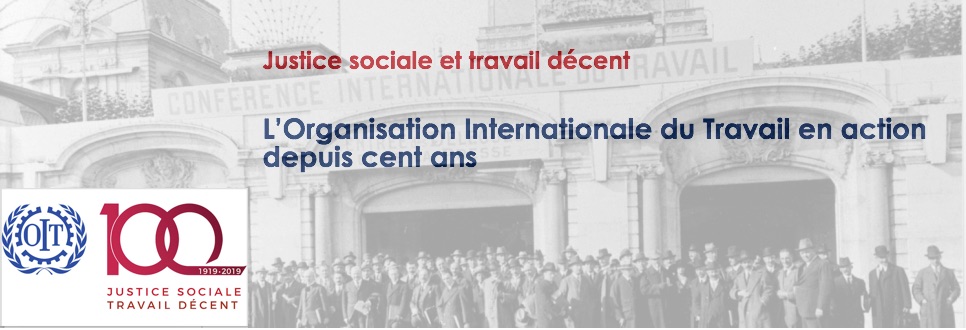Le Service du travail des femmes et des enfants est créé au Bureau international du travail à la fin de l'année 1933, dans le cadre d'une réorganisation générale destinée à effectuer des économies. Sa création traduit également une plus grande attention à la question du travail des femmes, menacé dans le contexte de la crise des années 1930 mais défendu par l'institution et notamment par celle qui assure alors la direction de ce service : Marguerite Thibert (1886-1982), auteure au printemps 1933 d'un article retentissant dans la Revue internationale du travail (« Crise économique et chômage féminin »). Le service, qui connait une éclipse au début de la Seconde Guerre mondiale, change de nom à plusieurs reprises et disparait en mai 1959, où ses tâches sont réparties dans plusieurs divisions, signe d'une approche désormais intégrée de la question Femmes. Seul subsiste un petit bureau de coordination, aux dénominations variables au cours du temps. En 1999 est créé le Bureau pour l'égalité entre hommes et femmes dont le rôle est de promouvoir l'égalité des sexes à travers toute l'Organisation internationale du travail. Aujourd'hui existe un Service des questions de genre, de l'égalité et de la diversité.
L'étude de long terme du service du travail des femmes et des enfants révèle bien des pans de l'histoire de l'OIT et permet d'en comprendre le fonctionnement. Sa création comme sa disparition interroge d'abord sur l'évolution de la signification de la catégorie « travailleuses » pour l'Organisation et sur le genre de sa politique sociale. Par ailleurs, il est intéressant d'observer la nationalité, la formation et les tâches des fonctionnaires qui composent le service : pour souligner l'internationalisation de l'OIT, organisation avant tout européenne dans les décennies 1920 et 1930 ; pour jauger la place longtemps subordonnée de femmes surdiplômées dans la hiérarchie administrative ; pour comprendre la triple fonction de l'Organisation (production d'un savoir d'expertise, élaboration de normes sociales internationales, tâches d'assistance pour qui la sollicite). Enfin, étudié dans ses relations avec l'extérieur, le service témoigne d'une perméabilité de l'OIT aux groupes extérieurs au tripartisme, en l'occurrence les mouvements féministes longtemps divisés sur la question d'une protection spécifique des travailleuses.
Les sources utilisées seront des archives du BIT de la série WN (Femmes) et P (Personnel), des écrits produits par l'OIT, ainsi que des correspondances privées (archives Marguerite Thibert et Marie-Louise Puech).
ENGLISH VERSION
The history of the ILO (International Labour Organization) seen through the Work of the Women and Children Service (International Labour Office)
The Work of Women and Children Service was created in the International Labour Office at the end of 1933 in the course of a general reorganization intended to reduce costs. Its creation reflected a heightened concern about women's work in the context of the economic depression. The Office and notably the head of the new service, Marguerite Thibert (1866-1982) sought to protect the female work force. In the spring of 1933 she was the author of an important article in the International Labour Review: “The Economic Depression and the Employment of Women.” The Service, which vanished at the beginning of World War II, reemerged and changed names several times before disappearing permanently in 1959 when its various tasks were allocated to different divisions––a sign of a new integrated approach to the Woman Question. What remained was a small coordinating bureau whose title also varied over time. In 1999 the Organization created the Bureau for Gender Equality whose role was to promote professional equality throughout the ILO. Today the latter has become the Gender, Equality and Diversity Branch.
The long-term study of the Work of Women and Children Service sheds light on a range of aspects in the history of the ILO while revealing as well the way it worked. The Service's creation and its disappearance raise questions about the significance of the category “women workers” for the Organization, as well as about the gender of social policy. Specifically, the analysis of the nationality, the training, and the tasks of the civil servants in the Service offers multiple perspectives: on the internationalization of the ILO which was a primarily European organization in the 1920s and 1930s; on the enduring subordination of highly educated women within the administrative hierarchy; on the three-fold function of the Organization (producing expert knowledge, developing international social norms, offering aid to those who solicited it). Finally, the study of the service in its exterior relations reveals the influence of groups that were not officially involved in the tripartism of the Organization, notably feminist groups who remained profoundly divided about the issue of specific protection for women workers.
The presentation draws on the archives of the International Labour Office, the series WN (Women) and P (Personnel), writings produced within the Organization as well as private correspondence (archives of Marguerite Thibert and Marie-Louis Puech).

 PDF version
PDF version
